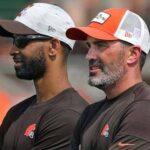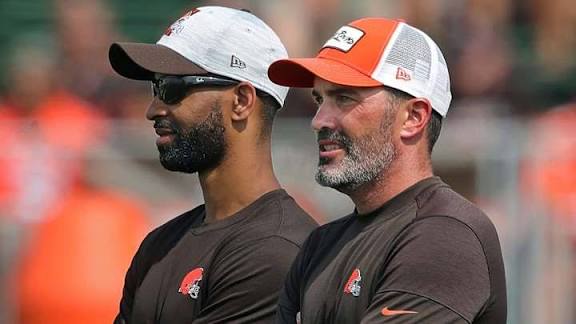Tiger Woods, Rory McIlroy and other PGA Tour stars are about to receive massive bonuses for their loyalty.
The Telegraph reported Wednesday that Woods will receive up to $100 million in equity as part of the newly created for-profit PGA Tour Enterprises, with McIlroy getting about half that amount.
The payouts, which are set to be disclosed to the players by PGA Tour commissioner Jay Monahan on Wednesday, are a way to thank players for sticking with the PGA Tour instead of jumping to the rival LIV Golf League and huge paydays from Saudi Arabia’s Public Investment Fund.
Nearly 200 players will receive a stake, with $750 million of it going to the top 36 players based on a formula that weighs career success and cultural popularity, according to The Telegraph. Other notable payouts include $30 million each for Jordan Spieth and Justin Thomas, while $75 million is targeted to go to notable retired players.
EDITOR’S PICKS
Sources: Rory to return to PGA Tour policy board
2dMark Schlabach
Norman: LIV open-minded about 72-hole format
15h
Tiger adds Homa, Kim, Kisner to TGL team
3d
To receive the money, players would have to continue to remain loyal to the PGA Tour, with the funds vesting over the next eight years, according to The Telegraph. And going forward, the PGA Tour plans to award $100 million per year to the players.
McIlroy, playing this week in the Zurich Classic of New Orleans, was asked Wednesday how much would make players feel validated for their decision to stay with the PGA Tour.
“I think the one thing we’ve learned in golf over the last two years is there’s never enough,” said McIlroy, who also said that he’s interested in returning to the PGA Tour’s policy board, as has been reported and is pending a board vote that could take place this week.
“At the end of the day, it’s not quite up to me to just come back on the board,” McIlroy said. “There’s a process that has to be followed.”
The other board members are Patrick Cantlay, Peter Malnati, Adam Scott, Spieth and Woods.
PGA Tour Enterprises received an investment of up to $3 billion earlier this year from Strategic Sports Group, a consortium of sports team owners that includes the New York Mets’ Steve Cohen and the Atlanta Falcons’ Arthur Blank.
A week later, Monahan outlined the first-of-its-kind equity ownership program in a Feb. 7 memo to players.
Any deal with PIF would most certainly increase the value of the equity shares.
A source with knowledge of the Player Equity Program told The Associated Press that the equity money is not part of the SSG investment. That money was geared toward growth capital.
Golf.com, which received a series of informational videos on the Player Equity Program that was sent to players, reported only 50% of the equity would vest after four years, 25% more after six years and the rest of it after eight years.
The 36 players from the top tier were judged on “career points,” such as how long they were full members, victories, how often they reached the Tour Championship and extra points for significant victories, Golf.com reported.
“It’s really about making sure that our players know the PGA Tour is the best place to compete and showing them how much the Tour appreciates them being loyal,” Jason Gore, the tour’s chief player officer, said in one of the videos obtained by Golf.com.
Emails also were sent to 64 players who would share $75 million in aggregate equity based on the past three years, and $30 million to 57 players who are PGA Tour members. Also, $75 million in equity shares was set aside for 36 past players instrumental in building the tour.
The program has an additional $600 million in equity grants that are recurring for future PGA Tour players. Those would be awarded in amounts of $100 million annually started in 2025.
Players only get equity shares from one of the four tiers now, although everyone would be eligible for the recurring grants.
Even with equity ownership geared toward making the PGA Tour better, the concern was players questioning who got how much and whether they received their fair share.
The PGA Tour and LIV are in merger talks, but they have been protracted, with no clear end in sight. Both tours have continued to operate independently, keeping many of the top names in golf from competing against one another for most of the golf calendar — major tournaments (Masters, US Open, British Open and PGA Championship) excepted
“I think I could be helpful to the process,” McIlroy said of a formalized unification of the PGA Tour and LIV Golf. “But only if people want me involved.”
He said he aims to promote compromise while also trying “to help people see the benefits of what unification could do for the game and what it could do for this tour in particular.”
“We obviously realize the game is not unified right now for a reason, and there’s still some hard feelings and things that need to be addressed,” McIlroy said. “But I think at this point, for the good of the game, we all need to put those feelings aside and all move forward together.”
LIV Golf CEO Greg Norman said Wednesday he is open-minded about the idea of moving to a traditional 72-hole format, though he explained that the Saudi-backed circuit would need to evaluate the impact of adding an extra round to its 54-hole, no-cut events.
Former Masters and U.S. Open champion Jon Rahm, who announced his decision to leave the PGA Tour and join LIV in December, has said he hoped LIV would move to a 72-hole format, as it would help unite the tours.
Norman said at a news conference Wednesday ahead of LIV’s event in Adelaide, Australia, that they were open to the idea of changing the format but noted there was an “economic impact about putting television on for 72 holes.”
“It’s a great conversation to have,” he said. “We will continue to have that conversation going forward. But we sit back and say, what value do we get on putting on television on Thursday? How do we build out in the future?
“There are things that we sit back and look at to see what is the most optimal solution to make this a better and better and better event, and 72 holes is discussed.”
Norman also dismissed a report that was published earlier this month by a London newspaper stating that LIV had made an $850 million offer to Rory McIlroy. “This is just typical white noise that gets out there in the industry,” Norman said.
McIlroy himself denied the report, saying neither he nor his agents have ever discussed a potential deal to lure him to the LIV Golf League, which is being financed by Saudi Arabia’s Public Investment Fund (PIF).
Rahm, speaking alongside Norman at Wednesday’s news conference, said there was a “level of comfort” in playing 72 holes but that any decision to change the format had to make business sense.
“At the end of the day, LIV is a business,” Rahm said. “If it doesn’t fit the product, it doesn’t fit the product.
“I’m just a player. There’s a lot of people that are a lot smarter than me that can figure it out and explain why they believe 54 holes may be better for them.”


